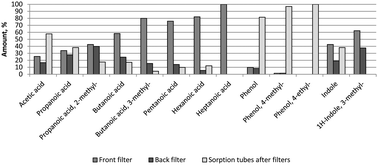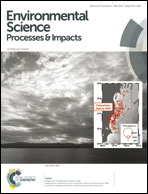Gas–particle partitioning of odorants in a pig house measured by thermal desorption GC/MS
Abstract
Odorous compounds identified in pig houses span a wide range of vapour pressures and may thus be present as volatile and semi-volatile compounds, but little is known about the partitioning between phases. In this study, the concentrations of 17 known odorants were measured in a pig house both in the gas phase and in particles. Particles were collected on PTFE coated glass fibre (GF) filters while gas phase compounds were collected using Tenax TA and Carbograph 5TD sorption tubes after the filtration. All samples were analysed using a thermal desorption gas chromatograph and mass spectrometer (TD-GC-MS). The effect of desorbing the filters at different temperatures (290, 200 and 100 °C) was investigated, and we found that a desorption temperature of 290 °C was optimal. Backup filters were placed behind the front particle sampling filter to account for adsorption of gas-phase compounds to the front filters (positive artefact). Adsorption of propanoic acid, butanoic acid and 4-methylphenol to GF filters and PTFE-coated GF filters was specifically investigated in the laboratory by measuring the air concentration with proton-transfer-reaction mass spectrometry. Both field and laboratory results show considerable adsorption of most compounds to filters, and the use of backup filters is necessary to account for this. Of the odorants investigated in this study, carboxylic acids (C4–C6) were the most abundant in the particles, which is ascribed to acid dissociation in the particles. The logarithm of the subcooled liquid vapour pressures, log p°L, plotted against the logarithm of estimated equilibrium gas–particle coefficients, log Kp, showed that the compounds were divided into two groups, polar and non-polar compounds, that showed linear trends with mr-values of −0.94 and −0.83 respectively. The study shows that it is possible to measure gas–particle partitioning by filters and TD-GC-MS. Only very low concentrations and low fractions of odorants were found in the particles measured in the pig house.


 Please wait while we load your content...
Please wait while we load your content...